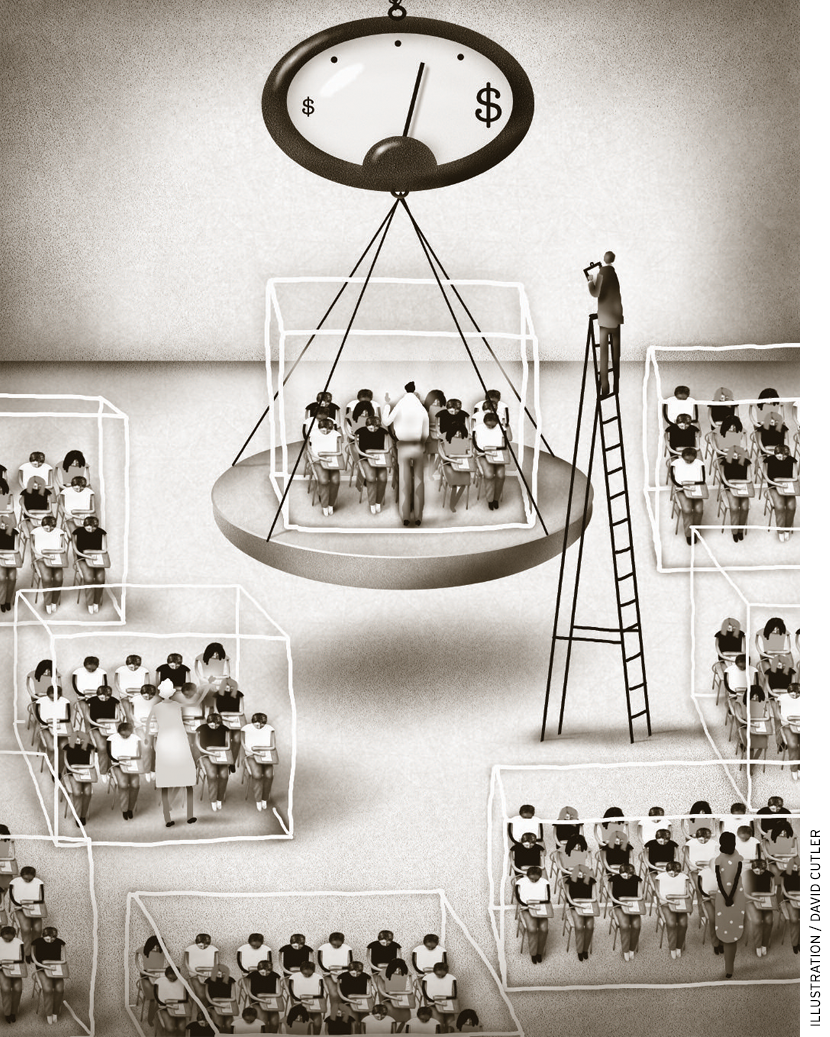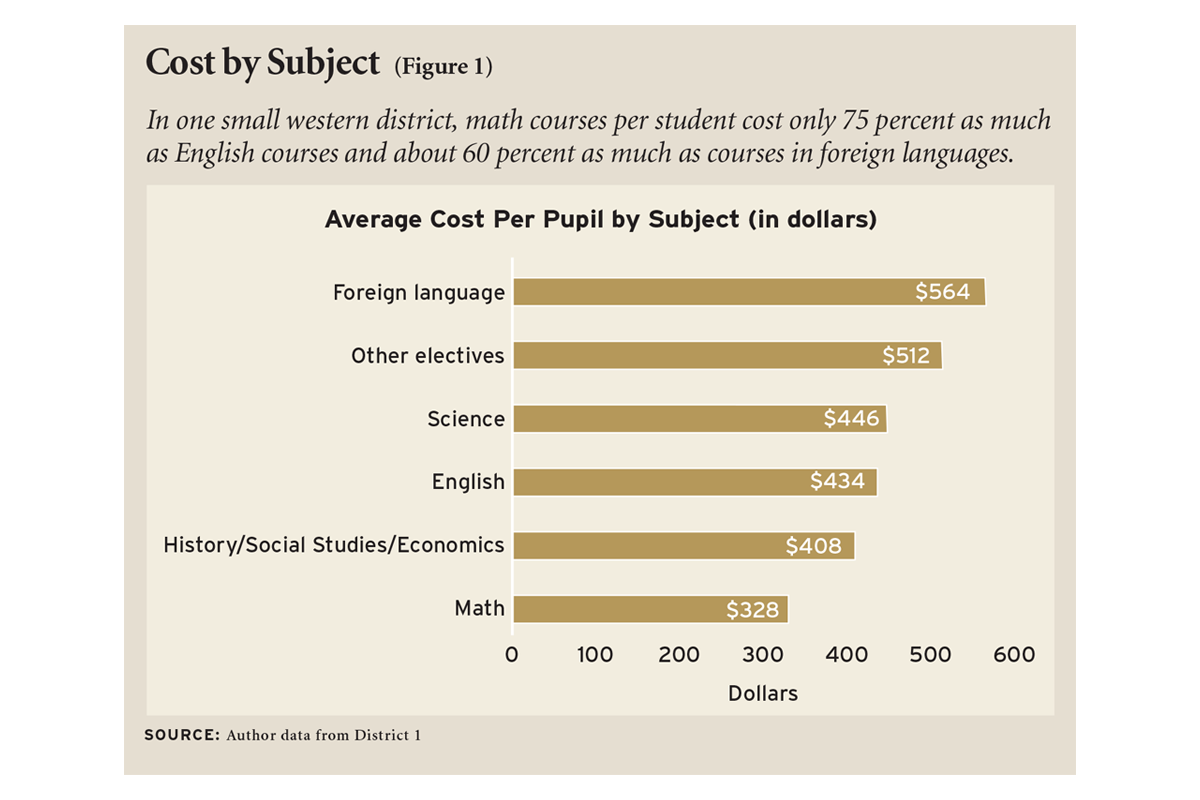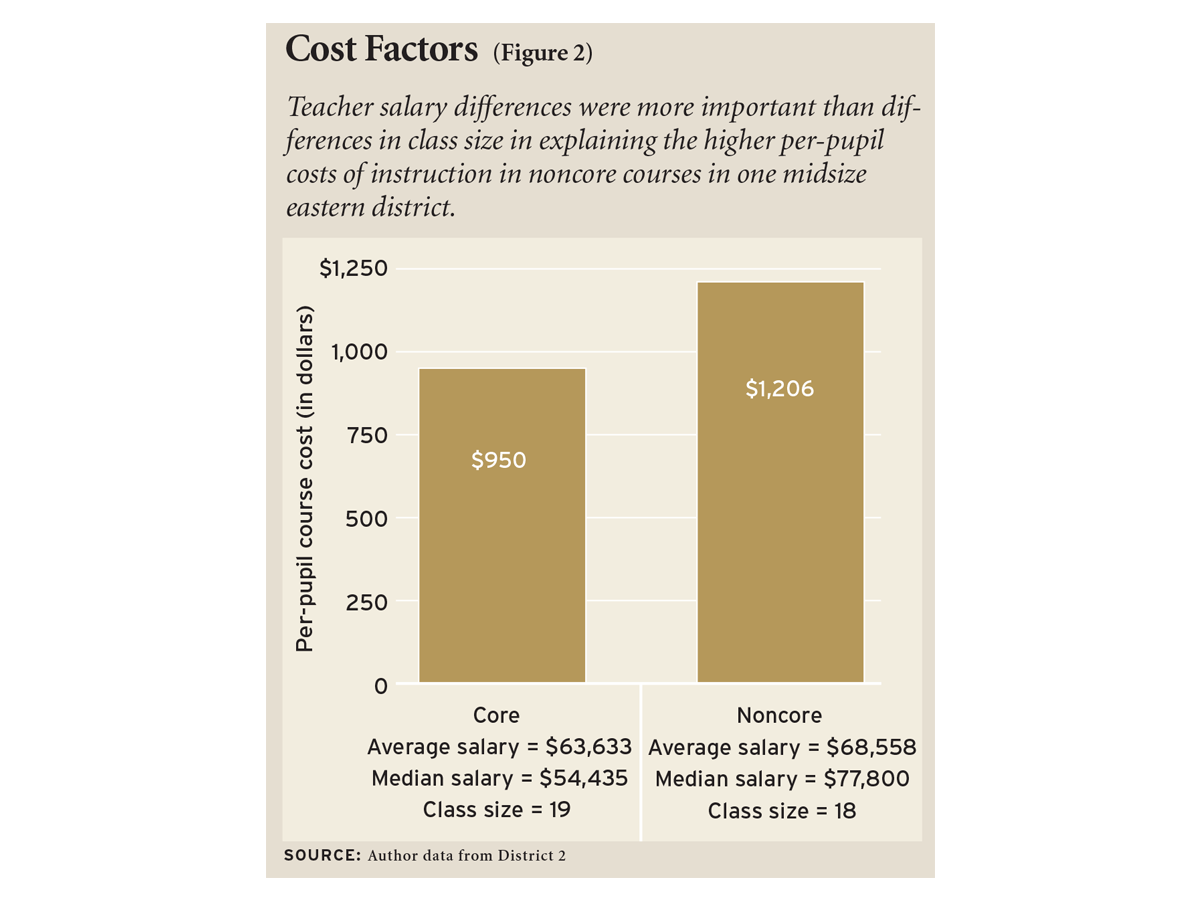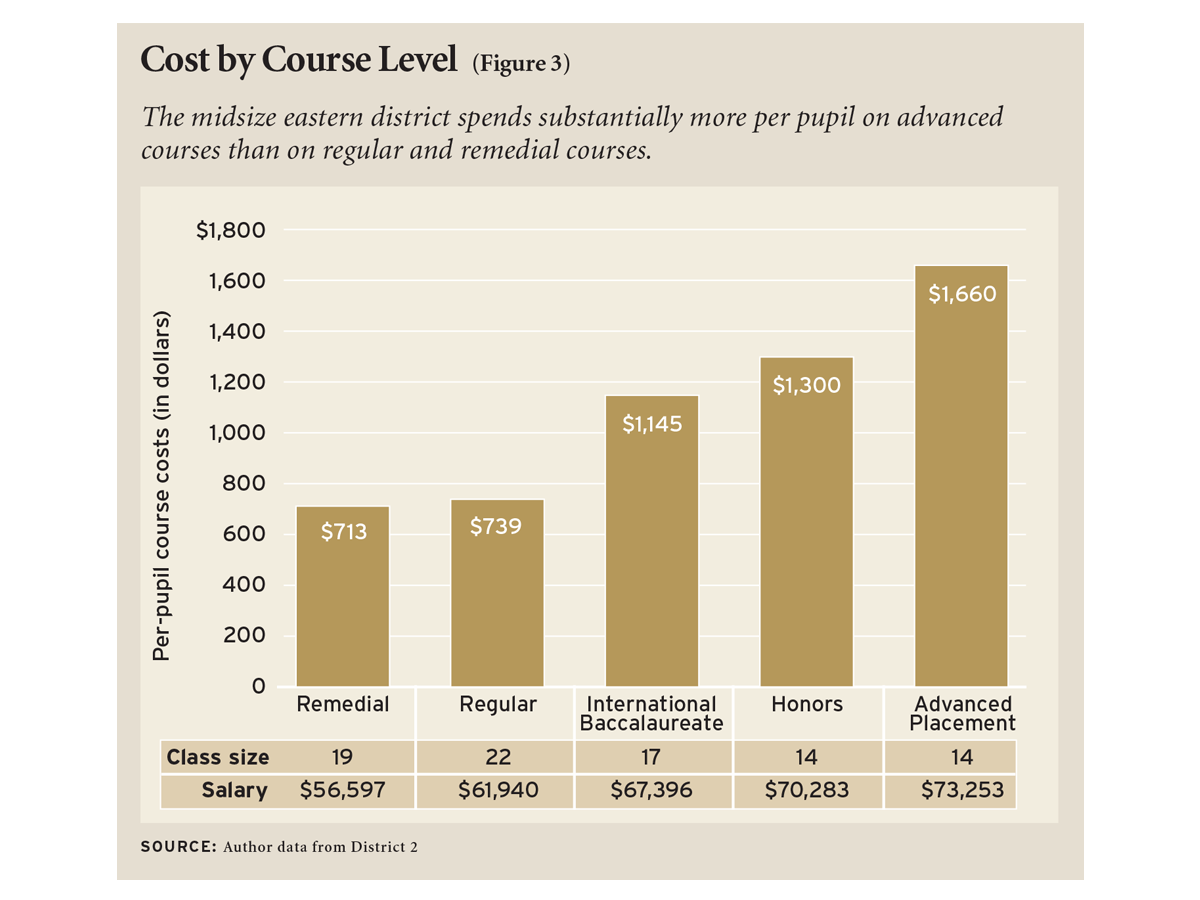 How much does it cost to provide a high school math course? What about remedial English? An Advanced Placement (AP) course in history? As the economic outlook continues to darken, school districts will be looking for ways to cut costs, and they will no doubt wrestle with some difficult issues. When does it make sense to keep classes small? When does it make sense to increase class sizes to cut costs? Such debates are often carried out in the absence of information about what actually happens in schools or what the options might be for reallocating scarce resources.
How much does it cost to provide a high school math course? What about remedial English? An Advanced Placement (AP) course in history? As the economic outlook continues to darken, school districts will be looking for ways to cut costs, and they will no doubt wrestle with some difficult issues. When does it make sense to keep classes small? When does it make sense to increase class sizes to cut costs? Such debates are often carried out in the absence of information about what actually happens in schools or what the options might be for reallocating scarce resources.
School districts produce reams of financial data to check off the right boxes on accounting and compliance reports required by states and the federal government. Typically missing is any financial analysis that follows the money into the school building to the classroom. Yet the classroom is where the mission-critical work happens and where the conversion of resources into services affects student performance. Educators need indicators that tell them whether the basic design and operation of their high schools direct resources in ways that sustain and enhance the district’s academic strategies and priorities. Academic outcomes are one such indicator. A measure of spending that enables comparison across service areas is another.
Computing spending patterns is not difficult. Per-pupil service expenditures can easily be determined at the classroom level. This analysis computes and reports spending on various services for high schools in three anonymous districts. The findings reveal the ways in which per-pupil spending varies by subject and course level.
While the findings are not intended to be suggestive of all districts in the country, the work does demonstrate how such fiscal metrics can reveal the financial implications of the inner workings of individual high schools. How much does a high school pay to offer electives, and how does that compare to what is spent on core subject courses? What are the cost implications of decisions regarding the structure of the school schedule, which courses to offer, and who teaches what course?
The findings presented in this article demonstrate how isolating spending on discrete services can 1) identify the relationships between priorities, current spending, and outcomes; 2) clarify both relative spending on discrete services and the organizational practices that influence how resources are deployed; and 3) establish the current cost of providing high school services as a necessary precursor to identifying whether there are better ways to provide some services.
Spending on Services
The spending-on-services approach to cost analysis aims to inform strategic resource decisionmaking by zeroing in on what is provided. This approach breaks out per-pupil expenditures by the discrete services students receive. This service-costing method is most appropriately categorized as a management tool, to be used on a periodic basis, rather than a new accounting system requiring continuous and extensive record keeping.
Service costing is not a wholly unexplored idea. In 1996, analyst David Monk and associates determined per-pupil expenditures for various courses in six high schools in four New York districts. They calculated per-course spending using actual teacher and aide salaries, course schedules, and course enrollments. These calculations indicated that the highest per-pupil course expenditures were associated with foreign language, music, and science instruction (excluding special education costs).
In 1999, Jay Chambers of the American Institutes for Research merged unique state-level databases containing information on teacher salaries, teacher course assignments, and course enrollment data to calculate per-pupil expenditures by course for students in Ohio. The results indicated wide variation in spending by course, with some elective courses—including Latin, AP Spanish, and drafting—costing twice as much on a per-pupil basis as algebra, literature, and composition.
In 2007 and 2008, the research summarized in this article added to this body of work by determining expenditures associated with a variety of services in high schools in three districts: District 1 is a small western district with one comprehensive high school; District 2 is a midsize eastern district with 10 comprehensive high schools; and District 3 is a midsize western district with six high schools, each divided into small learning communities.
The districts provided information on teacher salaries and stipends, teacher assignments and teaching loads, course offerings and schedules, teacher aide salaries and placements, and student participation in various courses. Each teacher’s actual salary (including stipends, where relevant) was then divided proportionately among the courses taught and the number of participating students. The approach yielded a per-pupil expenditure based on the proportionate teacher and aide compensation. This per-pupil figure does not fully recognize all inherent expenditures (for instance, the costs of school leadership, school facilities, and district-provided shared services). It does, however, provide a means of making comparisons in spending across courses, as the excluded costs don’t vary. The expenditure data were aggregated to allow for comparisons across subjects (e.g., math vs. foreign language), types of courses (e.g., core courses vs. electives or foreign language), course levels (remedial vs. honors), and grade levels (9th vs. 12th).
The following sections provide examples of spending-on-service findings from the three districts studied.
Results
Figure 1 shows the range of per-pupil costs in District 1: electives came at a cost of $512 per pupil versus $328 per math class, $434 per English class, and $564 per class in a foreign language.
District 2 also spent less per pupil on average for core courses (math, science, English/literature, and social studies/history/economics) than for noncore courses, which include electives and foreign language. District 3, however, directed a larger share of its dollars into core courses, so on average 19 percent more was spent per pupil on core courses than on noncore courses. Thus, the spending patterns varied among the three districts studied, indicating that one cannot assume that patterns found in one locale apply everywhere.
What drives these cost differences? As the reader would expect, teacher salary and class size are key variables, since these expenditure figures are computed primarily by dividing each teacher’s salary across that teacher’s course obligations and then dividing the per-course values by the number of pupils enrolled. A comparison of these variables in District 2 indicates that both lower class sizes and higher salaries in the noncore courses contributed to the differences in per-pupil course spending (see Figure 2). Teachers in some subjects taught fewer classes, which also had implications for the spending differences.
Here again, the pattern varied a bit among the districts, but in all three, the average salary of teachers who teach electives was meaningfully higher than that of core course teachers. In District 3, where per-pupil spending per noncore course was lower than for core courses, it was because the noncore courses had larger class sizes, not because the core teachers received higher salaries. Art and photography courses, for instance, were filled with many more students than English and math classes.
Comparing across Levels
The high schools studied spent more per pupil on higher-level courses than on mid-level or low-level courses. For example, in District 2, average spending across high schools on AP courses was $1,660 per pupil per course, while spending on regular courses averaged $739 per pupil and spending on remedial courses averaged $713 per pupil (see Figure 3). Advanced Placement teachers earned more than teachers of remedial courses ($16,656 more) and taught smaller classes on average (14 students vs. 19 students). While it wasn’t district policy to place more senior, higher-paid teachers in AP posts, district officials acknowledged that more senior teachers were given their choice of courses and most often opted to teach at the AP level. Differences in class size were in part a function of a state-imposed limit on AP class size.
In District 3, spending on regular and honors courses was on par, while the cost per student was 28 percent higher for the International Baccalaureate courses. In District 1, per-pupil spending on honors and AP classes exceeded spending on regular classes by 80 percent in math and 23 percent in English (the two subjects where courses were broken out by level).
We can also use these results to estimate what is being spent on a set of core courses (say, junior level math and English, U.S. history, Spanish III, and chemistry) for different segments of the student population. For a junior taking these five courses at the honors level in District 2, for example, expenditure would total $6,910. For a junior taking these same five courses at the regular level, the expenditure would total $2,767.
Implications for Public Education
The policy landscape includes many school and district leaders engaged in high school redesign. While redesign has generally been considered a strategy to improve outcomes for students, with budget tightening ahead redesign may also be a strategy for enabling schools to do more with less. Relevant questions include, What factors contribute to relatively high costs for some subject areas and course levels? In what areas are higher investments accompanied by strong (or weak) outcomes? How can district and school leaders use the information to manage their resources efficiently and effectively?
To take the next step, school leaders need to look at outcomes. Where expenditures on a high-priority service are relatively low and there is dissatisfaction with the outcomes, then the question is, What changes are needed to improve outcomes? The cost-of-services model can also uncover relatively high spending in an area of low priority. Making changes to reduce costs in one place frees up funds for redirection to a high-priority area.
For management, the exercise is to identify the key cost drivers, recognize how various organizational features such as class sizes, teacher assignments, and the school schedule work to affect spending, and then make decisions deliberately about how best to use resources. In the schools studied here, staff compensation and class size were two obvious key cost drivers, but other factors played a role as well. What follows are selected cost factors that present opportunities to make trade-offs between services. In education, where investments have risen steadily for several decades, providing new services has often meant raising new funds. With current projections forecasting more constrained public funds in coming months, the resource landscape will likely be one of greater scarcity, which will only increase the likelihood that schools will have to consider such trade-offs.
Teacher salary schedules and assignments. Schools may have difficulty attracting or retaining effective teachers to positions that are deemed high priority, such as teaching remedial courses in core subjects. A relatively low per-pupil cost for those courses may be viewed as underinvestment. If so, education leaders might want to make available more funds for the salaries of teachers of remedial courses and, if necessary, look for other areas in which costs can be reduced. Calls for teacher salary differentials as a tool for recruiting teachers in hard-to-staff subjects indicate some interest in the idea.
In the three districts studied here, teachers taught a set number of courses. Reducing responsibilities for some teachers and increasing them for others is another way of reallocating resources.
Class size and course offerings. Recognizing how class size affects the per-pupil cost of delivering services can aid in strategic allocation of scarce resources. Faced with relatively high per-pupil costs for music classes and limited funds, District 3 chose to offer fewer (larger) music classes as a deliberate strategy to free funds for more (smaller) core courses. This decision to shift resources reflects a trade-off in which something is both gained and lost. Smaller classes in the core are made possible by accepting larger enrollments and fewer offerings in music. Some states or districts limit class sizes for AP or gifted courses, which increases the per-pupil cost for these courses. The trade-off is fewer resources for other courses.
School schedules. The daily school schedule affects the way resources are deployed across subjects. In the three districts studied, each course was allocated equal time on the daily and weekly schedule, resulting in an even allocation of each teacher’s salary across the courses taught. If school leaders wish to increase investment in core classes, one option is to lengthen the class periods for those classes. Some schools provide double blocks (class periods that are twice as long as a regular class period but still meet every day or nearly every day) in math, science, and literacy. Increasing the time allocated to core courses requires a trade-off that may imply shorter or less-frequent classes for noncore courses (for example, a photography course may meet two or three days a week instead of five) or a reduction in the number of noncore courses students can take.
Fueling Innovation
Spending-on-services calculations can be used to establish current per-pupil costs as a precursor to seeking better ways to provide certain services to students. In a market economy, the cost of a service or product is determined by what sellers and buyers agree to. This occurs in higher education, resulting in a range of educational options at a variety of costs. But K–12 public education for the most part functions as a monopoly, and expenditures are far removed from recipients (or their parents) and often are not even known by their providers (schools and districts).
In Out of the Box: Fundamental Change in School Funding, David Monk discusses the idea of schools providing a limited base program but then allowing parents to pay for extra services not deemed part of the base (such as music). For such an idea to work, Monk acknowledges that schools would need to create a closer link between these extra services received and prices paid. Similarly, Frederick Hess and Bruno Manno call for “unbundling” services, whereby schools might contract out some of the services they provide as a way to open up demand and encourage new suppliers of school services. For instance, schools might contract with local providers to offer electives or sports and might pay a distance-learning provider to offer AP courses.
Spending-on-services analysis fits well with this angle on innovation in that it defines the costs of each service in a way not regularly considered in K–12 schooling. Defining investments in per-participant terms can help spur cost comparisons to services offered by alternative providers. For instance, before school leaders move to eliminate relatively high-cost art or music classes, they may look to see whether local providers (community centers, local colleges, etc.) can or already do provide similar services at better prices. Where schools pay a high per-pupil amount to offer some courses (for example, AP Spanish or remedial reading) to a small number of students, they may find lower-cost options exist via distance learning or contracted services. By freeing up resources in those areas, education leaders can direct more resources to other subjects and students.
Conclusion
In most large, complex organizations the cost of mission-critical functions is closely tracked so that leaders can take stock of how different practices come together to affect resource use. The approach outlined here provides one means to do just that in high schools. Application of the spending-on-services model to high schools clarifies per-pupil costs and the influence of organizational features on resource allocation.
In the coming years, forecasts suggest that education leaders will likely be asked to do more with less. While in the near term the implementation of some of the options noted above may be impeded by contracts and other obligations, over the long term the spending-on-services approach can provide a new lens through which education leaders can view high school redesign. In sum, the spending-on-services approach takes the blinders off, providing education leaders with a powerful tool to inform local resource decisionmaking.
Marguerite Roza is senior scholar at the Center on Reinventing Public Education and a research associate professor at the University of Washington College of Education.





